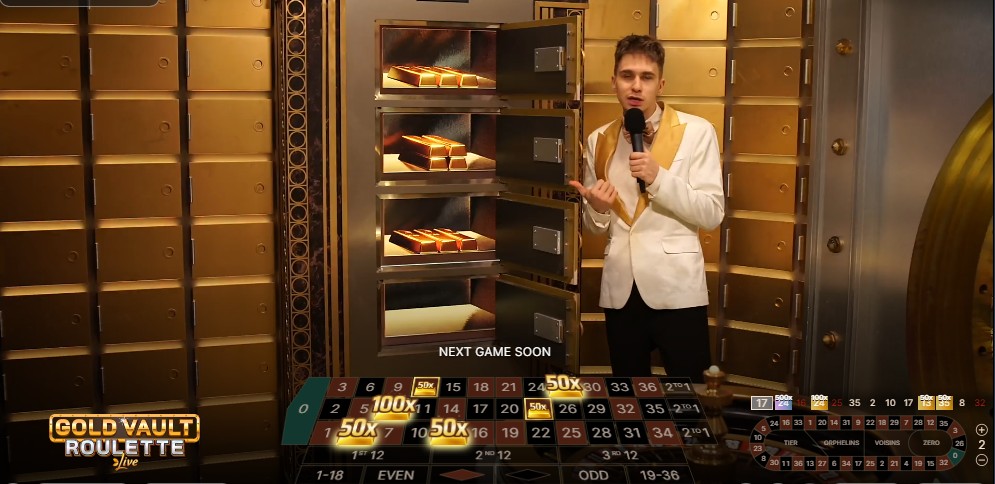Complete Guide to Gold Vault Roulette


Play Gold Vault Roulette at Tower.bet!
- Deposit $25, Get $45 BONUS
- Up to 30% Rakeback
- Races, Airdrops, Staking


Evolution Gaming's Gold Vault Roulette merges traditional European roulette mechanics with a dynamic multiplier system, creating a unique hybrid experience that demands both strategic planning and risk management. This guide provides an in-depth examination of the game's structure, mathematical nuances, and practical considerations for players navigating its golden payout landscape.
Following the standard betting phase, Gold Vault Roulette introduces a four-stage reveal sequence where vault doors open to distribute 5–20 golden markers across the number grid. These markers exclusively enhance straight-up (single-number) bets through three distinct multiplier tiers. The base 50x gold bars assign randomly to numbers, permitting accumulation up to three stacked bars (150x total). A rare 500x purple bar appears in 0.27% of rounds, replacing rather than combining with standard multipliers. The subsequent ball spin determines the winning number, with multipliers activating only if the victorious number holds gold bars. All other bet types—including splits, streets, and outside wagers—maintain fixed payouts unaffected by the multiplier system.
| Multiplier Type | Frequency | Effective Odds |
|---|---|---|
| 50x Single | 37.8% per number | 1:2.65 |
| 50x Double (100x) | 8.9% per number | 1:11.24 |
| 50x Triple (150x) | 1.2% per number | 1:83.33 |
| 500x Jackpot | 0.27% per round | 1:370.37 |
The game modifies European roulette's traditional 35:1 straight-up payout to a variable 24:1–499:1 range based on multiplier assignments. Split bets retain their standard 17:1 return, street bets at 11:1, corner bets at 8:1, and line bets at 5:1. Outside wagers maintain conventional payouts (1:1 for red/black, 2:1 for dozens/columns). This creates divergent return-to-player (RTP) percentages: 97.03% for straight-up bets versus 97.30% for other wagers. The reduced straight-up RTP stems from lowered base payouts (24:1 minimum) partially offset by multiplier frequency—a mathematical tradeoff that increases house edge to 2.97% on number-specific bets while keeping outside wagers statistically identical to standard European tables.
| Bet Type | Payout | RTP | House Edge |
|---|---|---|---|
| Straight Up | 24:1–499:1 | 97.03% | 2.97% |
| Split | 17:1 | 97.30% | 2.70% |
| Street | 11:1 | 97.30% | 2.70% |
| Corner | 8:1 | 97.30% | 2.70% |
| Line | 5:1 | 97.30% | 2.70% |
Gold Vault's volatility profile dwarfs traditional roulette variants through two mechanisms: amplified payout variance and perceptual hit frequency distortion. The standard deviation per 100 spins measures ±$3,150 compared to European roulette's ±$980, reflecting 220% greater financial swing potential. While multipliers create the illusion of frequent wins (13.5–54.1% of numbers active per round), actual ball landing probabilities remain fixed at 2.70% per number. This dissonance between visual excitement and mathematical reality necessitates strict bankroll protocols—experienced players typically allocate 3% per straight-up bet versus 1.5% in standard games, preserving 90% of funds for 10+ betting cycles to weather volatility storms.
The 25-second post-reveal betting window demands strategic preconfiguration through the Favorite Bets system. Savvy players store complex wager combinations like tiered neighbor bets (7–9 adjacent wheel numbers) for rapid deployment on multiplier-dense sectors. Complete bets prove particularly effective—a $10 complete bet covering all inside positions on a 50x-active number yields $240–$1,500 returns versus traditional $350 payouts. However, the interface's glowing markers and vault animations risk inducing chase behavior, particularly when numbers display consecutive 50x markers. Countermeasures include setting session limits (e.g., 50 spins maximum) and loss thresholds (e.g., 50% bankroll depletion).
| Feature | Gold Vault | European | American |
|---|---|---|---|
| Straight-Up RTP | 97.03% | 97.30% | 94.74% |
| Max Multiplier | 499:1 | 35:1 | 35:1 |
| Volatility (SD/100) | ±$3,150 | ±$980 | ±$1,050 |
| Zero Rules | Standard | La Partage | Double Zero |
The $0.20–$5,000 betting range creates asymmetric risk profiles across player tiers. Minimum bets rarely interact meaningfully with multipliers—a $0.20 stake on a 50x number yields $10, barely exceeding table minimums. High rollers face constrained recovery potential due to the $5,000 cap, particularly when pursuing progressive strategies. The game's hybrid nature—combining roulette mechanics with slot-style features—demands adjusted expectations; while the 500x jackpot provides lottery-style excitement, its 0.27% activation rate makes it statistically negligible for bankroll planning. Disciplined play requires ignoring interface-induced biases, particularly the tendency to overvalue numbers with previous multipliers or misinterpret the 500x's rarity as impending.
Gold Vault Roulette succeeds as an entertainment product by enhancing roulette's visual drama through multiplier mechanics, but comes at measurable statistical cost. The 2.97% straight-up house edge and extreme volatility make it mathematically inferior to standard European tables, though still favorable compared to American roulette or slot machines. Players prioritizing theatrical excitement over optimal odds may find value in moderated sessions, while probability-focused bettors should recognize the tradeoffs inherent in its design. Ultimately, the game serves best as a transitional experience for slot enthusiasts exploring table games, offering familiar jackpot thrills within a structured probability framework.